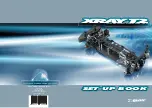
1
TRacK-WIdTH - THEORY
EFFEcTS OF TRacK-WIdTH adJUSTMENT
TRacK WIdTH - MEaSURING
frOnT TrAck-WIDTH
WIDER
·
Decreases front grip.
·
Increases understeer.
·
Slower steering response.
·
Use to avoid traction rolling.
NARROWER
·
Increases front grip.
·
Decreases understeer.
·
Faster steering response.
reAr TrAck-WIDTH
WIDER
·
Increases rear grip at corner entry.
·
Increases high-speed on-throttle steering.
·
Use to avoid traction rolling.
NARROWER
·
Increases grip at corner exit.
·
Increases high-speed understeer.
·
Increases front grip in hairpin turns.
1.mm shim
(left & right sides)
NO shims used
FRONT TRACK WIDTH
18mm
18mm
REAR TRACK WIDTH
18mm
18mm
TRACK-WIDTH
Track-width is the distance between the outside edges of the wheels,
front or rear, and it affects the car’s handling and steering response.
It is important that front or rear track-width is adjusted symmetrically,
meaning that the left and right wheels must be the same distance
from the centerline of the chassis.
Making the track-width narrower can be compensated with adding
shims on the wheel axles to make the offset larger.
NOTE: CHANGING FRONT TRACK-WIDTH SETTING WILL ALSO AFFECT THE FRONT TOE AND CAMBER SETTING.
TRacK WIdTH - adJUSTING
Normally you cannot adjust the track-width of a car with C-hub suspension due to the design of the suspension system. However, the T suspension
system allows you to easily adjust the track width by adding/removing shims between the suspension holders and the bulkheads.
Make sure to use the same amount and thickness of shims on both left and right sides.
The amounts of shims used in the T suspension will determine the track-width settings.
Increase Track-width
(WIDER)
More/thicker shims
Decrease Track-width
(NARROWER)
Less/thinner shims
FRONT TRacK-WIdTH
REaR TRacK-WIdTH













































